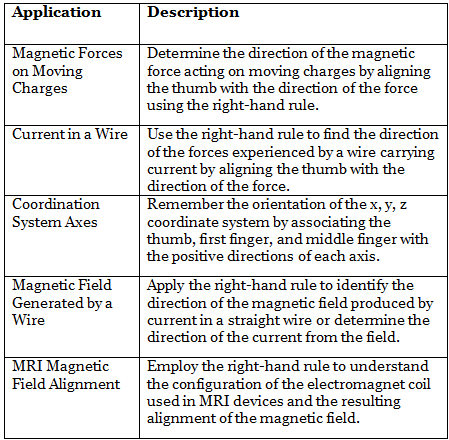Understanding Magnetic Forces and Fields | Physics for MCAT PDF Download
Introduction
Physicists utilize a memory aid known as the right-hand rule to assist in remembering the orientation of magnetic forces. This rule is grounded in the fundamental connection between magnetic fields and the forces they apply on moving charges. By employing this mnemonic, physicists can readily ascertain the desired directions. Nevertheless, it is crucial to employ the right hand, as utilizing the left hand may result in erroneous predictions.
The Right-Hand Rule
In order to employ the right-hand rule, physicists form an L-shape using the thumb and the first two fingers of their right hand. The middle finger is then extended at a right angle to the thumb and index finger. This arrangement of the hand aids in visualizing the correlation between magnetic fields and the forces they apply.
Magnetic Forces on Moving Charges
When charges are at rest, magnetic fields have no effect on them. However, once charges begin to move, they encounter a magnetic force. It's important to note that the direction of this force differs from that of the magnetic field lines. Physicists can use the right-hand rule to determine the direction of the magnetic force acting on a moving charge. By aligning the index finger in the direction of the positive charge's motion and the middle finger in the direction of the magnetic field, the thumb indicates the direction of the magnetic force on the charge. For negative charges like moving electrons, the force points in the opposite direction to that of the thumb.
Current in a Wire
When discussing conventional current in a wire, it signifies the flow of positive charges. Just like individual moving charges, a wire that carries current experiences the influence of a magnetic field. To determine the resulting forces, physicists can employ the right-hand rule. By aligning the index finger with the direction of the current flow, the middle finger with the direction of the magnetic field, and the thumb with the direction in which the wire is pushed, physicists can readily ascertain the direction of the forces exerted on the wire.
Coordination System Axes
The application of the right-hand rule extends beyond magnetic forces and can also assist in recalling the orientation of axes in a standard x, y, z coordinate system. Following this rule, the thumb indicates the positive x direction, the index finger represents the positive y direction, and the middle finger points to the positive z direction. This mnemonic simplifies the understanding of orientation and enhances spatial visualization abilities.
Magnetic Field Generated by Current in a Wire
Moving charges not only undergo the influence of magnetic fields but also have the ability to produce them. Physicists employ a second right-hand rule to ascertain the magnetic field caused by current flowing through a straight wire. By aligning the right thumb with the direction of the current and curling the fingers, one can determine the orientation of the magnetic field. The fingers will curl in the same direction as the magnetic field encircling the wire.
Conversely, if the direction of the magnetic field is already known, the right-hand rule can be reversed to determine the direction of the current in the wire. By pointing the thumb in the direction of the magnetic field and curling the fingers, the circular direction taken by the fingers indicates the direction of the current responsible for generating the magnetic field. This concept is observed in electromagnets, where current flows through a wire coiled in a spiral shape. The coil produces magnetic field lines aligned with the long axis of the coil.
Relationship Between Magnetic Fields and MRI
Magnetic Resonance Imaging (MRI) makes use of a powerful static magnetic field to align the protons attached to water molecules inside a patient's body. This alignment serves as the first step in creating a map of the density and structure of various body parts. To generate a strong magnetic field in a specific direction, such as along the body's axis, an MRI machine incorporates a large coil electromagnet that surrounds the patient. By applying the right-hand rule, the circular current flowing around the patient in the coil produces a magnetic field that aligns parallel to the patient's body.
Summary of Right-Hand Rule Applications

|
158 videos|21 docs|21 tests
|




















